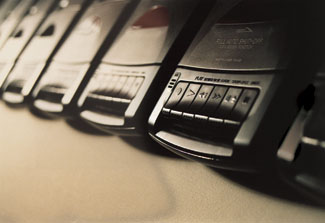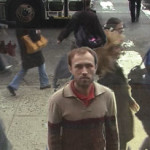By JACQUELINE HOUTON
Fully embracing Duchamp’s declaration, “The spectator makes the picture,” Cambridge’s Art Interactive has for five years displayed cutting-edge art that invites audience participation. Its latest show, Soundmarks, removes the picture from the equation, avowing that sound can be as rich a source for art as imagery. Unfortunately, the exhibition fails to fully realize the promise of this intriguing premise, for its emotional and intellectual power only sporadically rises above the level of white noise.
Soundmarks comprises five sound and video installations, two by Amy Stacey Curtis and three by collaborators Zach Poff and N. B. Aldrich. The latter works incorporate the most sophisticated uses of technology—yet as The Sentiment Machine showed, the artists’ high-tech talents don’t always translate into an affecting or thought-provoking experience. Fifteen speakers dangle from the ceiling in this remarkably un-interactive installation, broadcasting audio clips from television staples like talk show interviews, news briefs, and police procedurals. A computer programmed to mimic conversational rhythms plays the clips at random from a database, but because there is no soul behind the sequencing, no larger significance rises from the work—other than a vague sense of the inanity of television today. That void may have been the artists’ intent, as the accompanying note remarks on the inability of computers to provide us with meaning, and highlights the persistent paradox of modern technology: machines designed to foster communication often end up hindering intimacy. It’s an important quandary (perhaps the defining one of our age), but I’ve seen it investigated in more interesting ways, and I cannot help but wonder about the artistic merit of a work whose seeming purpose is to show that a computer cannot make meaning as an artist can—a truth we already know intuitively.
Still greater technological prowess features in The Aural Ecosystem, a “habitat” of synthesizers that emit a variety of twittering “mating calls” in response to changes in the gallery’s noise and light levels. Looking like metallic stalks of corn, these inorganic organisms are connected by a tangled root system of wires, which lead to a computer that records the conceptions, births, and deaths of the population. The creation of this artificial ecosystem is quite a feat, but the metaphor felt rather sterile, and didn’t reveal much about our own relationship to the sensory environment.
More emotionally resonant was Poff and Aldrich’s third installation, the evocatively titled The Past is a Ghost. Indoor and outdoor monitors display a feed from an exterior camera, which records the street scene outside the gallery passively until a pedestrian stops to take a closer look; then the background fades out, engulfed by shadowy and distorted images from past footage. The individual in the foreground will likewise become part of the virtual palimpsest, and the eerie effect evokes the persistence of history, reminding us that human actions leave lasting reverberations. My only question is how this installation, which generates no sound, complements the exhibition’s theme. The program references John Cage’s assertion that “silence is non-existent,” yet the radical composer’s infamously note-free composition 4’33” was a purposeful exploration of this idea; here, its invocation feels like an afterthought, a convenient explanation for the absence of audio rather than an integral component of the work.
Amy Stacey Curtis likewise plays with traces of the past in Exchange, a time-lapsed game of telephone mediated by more basic technology. Curtis culled eighteen nine-word sentences from books about Cambridge and recorded each on a separate tape deck, which visitors are invited to play once before recording over the previous message with their own account of the sentence. The cassettes constantly evolve as participants lend their voices to the work, and while each individual’s contribution is necessarily ephemeral, it undeniably changes the course of what follows. As in the children’s rendition of the game—and in life generally—that course is impossible to predict: some messages survive relatively intact while others metamorphize dramatically (one sentence was reduced to the enigmatic phrase, “ancients and werewolves”) or fall victim to playful sabotage (as in the case of an impromptu beatboxing performance).
Rather less suggestive was Curtis’s second installation, Labyrinth, which had visitors donning headphones and journeying up and down the gallery, their steps cued by a series of piano notes recorded on CD. In this site-specific exercise, a higher tone indicated a step forward by one tile; a lower tone, a step backward. Labyrinths are meant to encourage contemplation, and Curtis was clearly trying to recreate the ritualized walk using sound instead of a physical path; however, it was hard to contemplate anything while trying to remember each tone so I could interpret the next. Despite my care, I still ended up two tiles away from my intended destination, wondering why I had spent the last seven minutes on what seemed an empty exercise.
Soundmarks is infused with some interesting ideas, even if a few works left a rather antiseptic aftertaste. But the exhibit suffered in execution: while the austerely industrial gallery space, with its metal floor tiles, high ceiling, and parallel-running walls of bare brick, may make a seemly showcase for visual art, it created an acoustical nightmare of rough reverb that interfered with the listening experience. The cheap Sony tape decks used in Exchange further amplified the ambient noise, which drowned out several participants’ parrotings. The only attempt at acoustical separation—an untreated wood partition that partially enclosed The Sentiment Machine—did little to insulate the installation, and many clips remained unintelligible.
Granted, I first visited the gallery during the bustle of opening night, and the situation was much better when I returned the following day as the gallery’s only visitor. But if the exhibition can’t withstand the presence of twenty visitors in a 2,500 square foot gallery, then the setting simply isn’t serving the works—an ironic shortcoming indeed for a show focused on the interplay between individuals and their aural environment, and for a venue devoted to fostering human interaction.
- Amy Stacey Curtis, Exchange, 7.8.7, 18 tape recorders, 18 cassette tapes, 18 pedestals, instructions, audience
- Zach Poff and NB Aldrich, The Past is a Ghost, software driven video installation, 2007
----
Art Interactive
"Soundmarks" is on view until August 18th at Art Interactive, located at 130 Bishop Allen Drive, Cambridge, MA.
All images are courtesy of the artists and Art Interactive.






